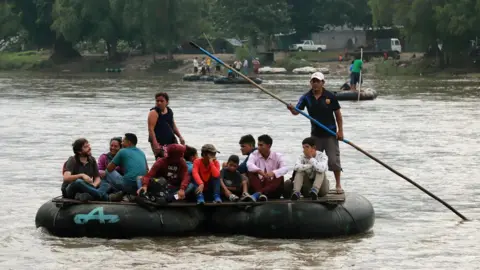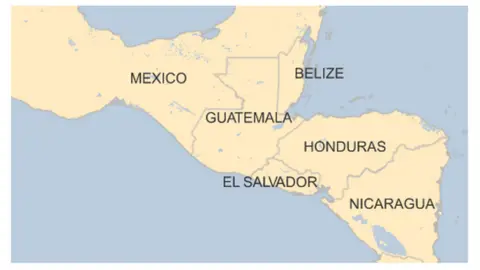Trump's asylum crackdown: Will the 'safe third country' plan work?
 AFP/Getty Images
AFP/Getty ImagesThe Trump administration has announced a new rule to curb Central American asylum claims in the US.
The measures say migrants must apply for asylum in the one of the countries they pass through en route to the US or they will be ineligible for consideration.
The plan goes into effect on Tuesday 16 July, having been unveiled the previous day.
Will it be possible? Here is a look at the various complications.
Shifting the responsibility
Migrants arriving at the US southern border are largely coming from Central American countries, including violence-stricken Honduras and El Salvador.
Most travel overland, passing through other countries en route. The US wants migrants to claim asylum in one of them. It is making these changes because its own migration services are overwhelmed.
However, other countries would also struggle to cope, and Mexico and Guatemala will be the most affected by this new plan as they are closer to the US.
Amnesty International says the Mexican asylum system is "underfunded, absolutely beyond its capacity and inadequate in identifying even valued asylum claims".

There is also a backlog of people who have already made the journey and are now stuck at the US southern border.
The US had already imposed the Migrant Protection Protocols (MPP) program - also known as "Remain in Mexico" - which forces asylum seekers to wait for their US court hearings on Mexican soil.
Who decides on 'safe' countries?
Migrants would only be expected to apply in another country if it is deemed "safe".
However, Central American migrants are also often deliberately sought out by gangs in neighbouring countries, because they are vulnerable. Many have reported finding the journey north as dangerous as their lives at home.
The US cannot declare a country to be a safe without the formal agreement of the place in question.
The US and Canada have such a reciprocal agreement. When asylum seekers arrive in the US from somewhere else, via Canada, they will be sent back to Canadian immigration authorities. The same applies in reverse.
So far, Mexico has rejected the US plan.
The outgoing Guatemalan president, Jimmy Morales, had been willing to discuss it with President Donald Trump, but the country's Constitutional Court temporarily blocked it on Monday.
Any third-country agreement would not apply when a country's own nationals seek to flee. Guatemalans and Mexicans are also fleeing their homelands - albeit not on such a large scale as some Central American countries.
The increased dangers
The US says there are exemptions to its new rule, including for migrants denied protection in a country and victims of human trafficking.
However, humanitarian organisations are concerned that people could start taking more dangerous routes to bypass official borders - perhaps even travelling by sea.
The legal problems
The new rule has not passed through US Congress, and was, instead, announced by the Justice Department and the Department of Homeland Security.
It is expected to be challenged in the country's federal court.
The American Civil Liberties Union said: "The Trump administration is trying to unilaterally reverse our country's legal and moral commitment to protect those fleeing danger. This new rule is patently unlawful and we will sue swiftly."
Under the 1951 UN Refugee Convention, there is no obligation on refugees to claim asylum in the first safe country they reach. Asylum seekers are protected against prosecution for illegal entry to a foreign country by Article 31 of the Convention.
In a statement, the UN Refugee Agency said the US measures would "endanger vulnerable people in need of international protection from violence or persecution."

Step into the shoes of a migrant
Maria is fictional. But everything that happens to her here is based on the real experiences of migrants who have travelled to America, experiences that have been documented by rights groups, journalists and lawyers.
See for yourself the decisions and dangers a migrant like Maria may face.
